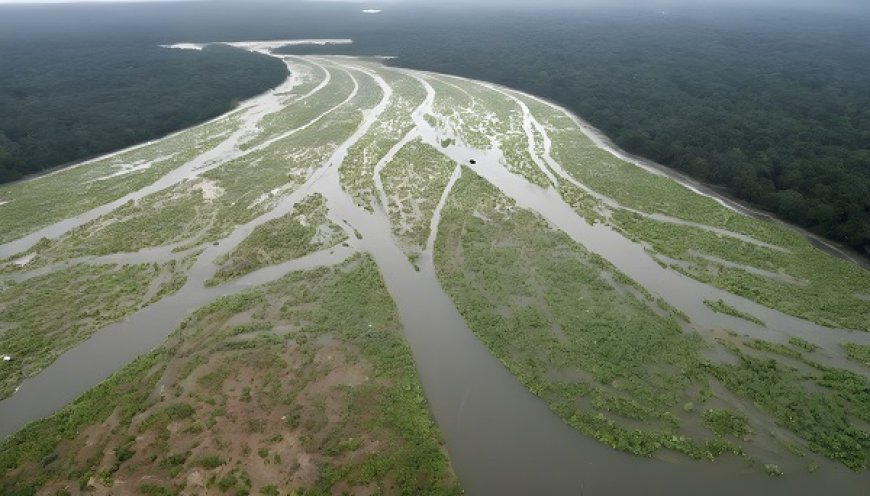Steps to adapt to climate change
Adapting to climate change is a multidimensional challenge that requires a precise understanding of climate variations and a comprehensive assessment of the associated risks and opportunities. This entails taking effective steps to develop comprehensive response plans, enhance resilient climate infrastructure, build strong awareness, and foster sustainable education to bolster adaptive capacities. It also involves promoting institutional collaboration and encouraging sustainable economic diversification.

Adapting to climate change is a multidimensional challenge that requires a precise understanding of climate variations and a comprehensive assessment of the associated risks and opportunities. This entails taking effective steps to develop comprehensive response plans, enhance resilient climate infrastructure, build strong awareness, and foster sustainable education to bolster adaptive capacities. It also involves promoting institutional collaboration and encouraging sustainable economic diversification.
Steps to adapt to climate change
1. Improving infrastructure and urban planning: This involves developing infrastructure to cope with climate change challenges such as creating flood management systems and designing heat and hurricane-resistant buildings.
2. Enhancing sustainable agriculture: This includes implementing sustainable farming practices and using efficient and drought-resistant irrigation techniques to ensure food security amidst climate change.
3. Developing renewable energy: Transitioning the economy towards using renewable energy sources such as solar, wind, and hydrogen is a fundamental part of climate adaptation strategies to reduce greenhouse gas emissions.
4. Promoting education and awareness: Raising awareness of the impact of climate change and the need for adaptation through education and community outreach is crucial.
5. Advancing prediction and response technologies: This involves developing systems to predict extreme weather events like storms and floods, as well as establishing effective emergency response and life-saving systems.
6. Strengthening partnerships and international cooperation: Countries, international organizations, and the global community must work together to exchange knowledge and technology and provide financial support for developing and implementing climate adaptation strategies.
7. Developing environmental policies: Comprehensive and effective environmental policies should be developed and implemented to promote climate adaptation and mitigate harmful greenhouse gas emissions.
In summary, climate adaptation strategies encompass a diverse range of actions and policies aimed at reducing the negative impacts of climate change and increasing the ability of humans and communities to adapt to these future challenges.
Steps towards environmental resilience
Steps towards environmental resilience represent a set of measures and policies aimed at enhancing the ability of individuals and communities to adapt to the impacts of climate and environmental change. Achieving environmental resilience requires adopting comprehensive strategies that include several key steps:
1. Understanding environmental and climate realities: Environmental resilience begins with a deep understanding of environmental and climate conditions in the area of concern, including the changes occurring and the potential impacts of these changes on the environment and communities.
2. Assessing risks and opportunities: This step involves identifying potential environmental and climate risks, assessing opportunities that may arise as a result of these challenges, and helping to identify strengths and weaknesses in environmental adaptation.
3. Developing plans and policies: Well-crafted plans and policies aimed at enhancing environmental resilience, such as risk management plans, sustainable urban planning, and natural resource conservation policies, must be developed.
4. Implementing preventive measures: This includes taking preventive measures to reduce potential environmental and climate impacts, such as providing flood-resistant infrastructure and planting trees to mitigate desertification effects.
5. Promoting awareness and education: Public awareness of the importance of adapting to climate and environmental changes must be raised, and necessary information and training provided to increase awareness and enhance adaptive capacity.
6. Strengthening cooperation and partnerships: Cooperation between governments, civil society, the private sector, and international organizations enhances the capacity to adapt to environmental and climate challenges through the exchange of knowledge, experiences, and financial support.
7. Implementing strategies and continuous evaluation: Policies and approved plans must be effectively implemented, with regular assessment of their success and the need for necessary adjustments to improve environmental resilience.
In summary, achieving environmental resilience depends on adopting comprehensive strategies that combine accurate analysis of the environmental situation with the continuous application of policies and preventive measures, while promoting awareness and enhancing cooperation among various stakeholders involved.
Enhancing climate resilience
Enhancing climate resilience is a comprehensive process aimed at strengthening the capacity of communities and individuals to adapt to climate change and mitigate its adverse effects. Achieving climate resilience requires implementing multifaceted measures to enhance communities' ability to adapt to significant changes in the environment. These measures encompass several important aspects:
1. Developing climate-resilient infrastructure: This involves improving and enhancing infrastructure to withstand climate impacts, such as developing flood management systems and upgrading sanitation systems to cope with increased rainfall.
2. Improving agricultural systems and natural resource management: Sustainable and efficient agricultural techniques must be developed to address climate challenges, such as modern irrigation techniques and climate-appropriate farming practices.
3. Community awareness and education promotion: Increasing awareness of the importance of climate adaptation and providing training and education to affected communities are essential for enhancing their understanding and capacity to take effective adaptive actions.
4. Promoting sustainable development: Climate adaptation should be integrated into sustainable development strategies, with a focus on achieving a balance between human needs and environmental preservation.
5. Developing policies and legislation: Effective policies and legislation must be developed and implemented to promote climate adaptation and enhance climate resilience for affected communities.
6. Strengthening cooperation and partnerships: Encouraging cooperation between governments, non-governmental organizations, the private sector, and civil society to develop and implement adaptation projects and enhance climate resilience.
7. Knowledge and experience sharing: International exchange of knowledge and experiences in community adaptation to climate change must be promoted to increase the effectiveness of efforts in this field.
Enhancing climate resilience is a comprehensive and ongoing process that requires collective efforts to address the challenges related to climate change and ensure the sustainability of the environment and communities in the future.
Environmental challenges through adaptation measures
Environmental challenges represent a significant part of the reality we face today, with the world experiencing major changes in the environment due to the impacts of climate change and unsustainable consumption patterns. These challenges require effective adaptive strategies to mitigate their impact and enhance climate resilience. Among the key challenges we face
1. Climate change and weather variability: The world is witnessing an increase in the frequency and intensity of extreme natural events such as floods, droughts, and severe storms due to climate change. These challenges require adaptive strategies aimed at reducing negative impacts and improving preparedness and response.
2. Declining water quality and scarcity: Many areas suffer from water scarcity and deteriorating water quality due to pollution and unsustainable exploitation. Countries need to implement measures to better protect and manage water resources, and develop techniques for water desalination and purification.
3. Biodiversity loss and extinction: The world faces significant losses in biodiversity and the extinction of many animal and plant species due to habitat destruction and environmental degradation. Measures must be taken to protect vital habitats and provide suitable environments for wildlife.
4. Increasing environmental pollution: Environmental pollution from organic, chemical, and industrial pollutants causes deterioration in air, water, and soil quality, leading to negative health and environmental impacts. Adaptation strategies include reducing harmful emissions and improving environmental cleanliness standards.
5. Desertification threats and agricultural land loss: The world faces challenges in combating desertification and the loss of agricultural land due to climate change and unsustainable land use. This requires adopting drought-resistant agricultural techniques and protecting agricultural land from desertification.
6. Waste management challenges: The volume, diversity, and negative environmental effects of waste are increasing, requiring measures to improve waste management and promote recycling and efficient resource utilization.
In summary, environmental challenges require comprehensive adaptive strategies aimed at reducing the negative impacts of climate change and increasing climate resilience. This requires joint and continuous efforts from governments, communities, and individuals alike.
Adapting to climate change
Adapting to climate change represents a significant challenge facing the world today, as the impacts of climate change on the environment and communities are increasingly pronounced. We must take effective actions to adapt to these changes and enhance our resilience to climate challenges. Adapting to climate change involves a set of measures and actions
1. Risk and opportunity assessment: Adapting to climate change requires a deep understanding of potential risks and available opportunities. It involves identifying environmental, social, and economic threats associated with climate change, and assessing opportunities for improving resilience and adaptability.
2. Developing climate-resilient infrastructure: It is essential to enhance infrastructure to be more suitable for climate change conditions, such as strengthening sewage systems to withstand increasing floods and constructing buildings resistant to earthquakes and storms.
3. Adopting sustainable agricultural practices: Agriculture is one of the sectors most vulnerable to the effects of climate change. Therefore, adopting sustainable agricultural practices that improve resource efficiency and reduce negative environmental impacts is crucial.
4. Improving water resource management: Many areas suffer from water scarcity due to climate change, making it necessary to improve water resource management to ensure the sustainability of freshwater and meet the needs of populations and agriculture.
5. Developing environmental technology: Technology can play a vital role in enhancing adaptation to climate change, such as developing renewable energy technologies and sustainable agricultural practices that contribute to reducing harmful emissions.
6. Enhancing awareness and education: Increasing awareness of the importance of climate adaptation and providing training and education to affected communities enable them to make informed decisions and implement effective adaptation measures.
7. Promoting international cooperation: International cooperation is essential in adapting to climate change, as environmental challenges have transboundary effects. Strengthening cooperation among countries to exchange knowledge and experiences and provide financial support for implementing adaptation measures is crucial.
In general, adapting to climate change requires joint and continuous efforts from governments, communities, and individuals to implement effective measures that improve resilience and mitigate the impacts of climate change on the environment and human life.
Building climate resilience
Building climate resilience is a comprehensive process aimed at enhancing the ability of communities and individuals to adapt to the impacts of climate change and mitigate its resulting damage. Building climate resilience requires adopting multi-faceted strategies based on comprehensive analysis of climate challenges and directing efforts towards achieving the following objectives
1. Assessing threats and opportunities: Building climate resilience begins with a thorough assessment of potential climate threats and available opportunities, including studying climate patterns and their potential impacts on the environment and local communities.
2. Developing climate infrastructure: This involves enhancing infrastructure to be more suitable for climate challenges, such as developing flood management systems and constructing storm- and earthquake-resistant infrastructure.
3. Capacity building: It is necessary to develop individuals' skills and increase their capacity to deal with climate change challenges through providing training, education, and necessary technical support.
4. Promoting sustainable practices: This includes adopting sustainable practices in various fields such as agriculture, industry, and construction, which contribute to reducing harmful emissions and improving environmental quality.
5. Providing financial and technical support: Providing financial and technical support is essential for achieving climate resilience building, as implementing adaptation measures requires significant financial investments and specialized technical support.
6. Encouraging cooperation and partnerships: Enhancing cooperation between local governments, governmental and private institutions, civil society, and international organizations to exchange knowledge and experiences and promote partnerships for implementing climate adaptation projects.
7. Developing policies and legislation: Effective policies and legislation should be developed to promote climate resilience building and encourage the adoption of sustainable practices, as well as provide necessary support for adapting to climate change.
In summary, building climate resilience requires integrated and continuous efforts by governments, communities, and individuals to enhance the ability to adapt to climate challenges and achieve environmental and social sustainability.
Enhancing environmental stability and resilience
Enhancing environmental stability and resilience is crucial in addressing the challenges of climate change and protecting the environment. This involves a series of measures and initiatives aimed at improving the capacity of communities and ecosystems to adapt to climate and environmental changes and respond to them effectively. Here are the details of enhancing environmental stability and resilience
1. Protecting vital natural areas: This includes establishing and managing protected areas and conserving biodiversity and essential natural resources such as forests, wetlands, and marine ecosystems. This helps preserve natural environments and reduce the negative impacts of climate change.
2. Promoting sustainable agriculture: This involves enhancing sustainable farming practices that reduce reliance on agricultural chemicals and preserve soil composition and biodiversity, thereby increasing agriculture's ability to adapt to climate change.
3. Improving water management: This includes enhancing the management of freshwater and deep-water resources, including developing techniques for water provision, storage, desalination, as well as promoting sustainable irrigation practices and flood management.
4. Developing disaster-resilient infrastructure: This involves constructing infrastructure that is resilient to disasters such as floods, storms, and earthquakes, as well as developing early warning systems and emergency plans.
5. Enhancing agricultural diversity: This includes promoting agricultural diversity and encouraging the cultivation of varieties resistant to harsh climatic conditions, as well as developing techniques for seed storage and preservation to ensure food supply continuity.
6. Promoting awareness and education: This involves directing efforts towards raising awareness about the importance of adapting to climate change and enhancing the knowledge and skills necessary for effective adaptation measures.
7. Enhancing cooperation and partnerships: It is essential to enhance cooperation between governments, institutions, civil society, the private sector, and international organizations to exchange knowledge and expertise and strengthen partnerships.
Sustainable development in the face of climate disparities
Sustainable development poses a significant challenge in the face of climate disparities, requiring a balance between meeting the needs of the current generation and preserving the ability to meet the needs of future generations amidst climate changes and their diverse impacts. Here is a detailed breakdown of sustainable development in this context:
1. Sustainable Infrastructure Development: Efforts towards sustainable development should include building infrastructure that is environmentally, economically, and socially sustainable. This involves investing in renewable energy, improving public transportation systems, and providing sustainable housing.
2. Promotion of Sustainable Agriculture: Sustainable agriculture must be promoted and its efficiency improved to achieve food security and reduce the negative impacts of climate change. This includes utilizing innovative agricultural practices and developing crop varieties resistant to harsh climatic conditions.
3. Development of Sustainable Economies: Sustainable development efforts should aim to enhance sustainable economic growth that takes into account environmental and social factors. This includes promoting entrepreneurship and innovation in green sectors.
4. Protection of Natural Resources: Natural resources must be effectively protected and managed to ensure their sustainability and provision for future generations. This includes forest conservation, improved water management, and biodiversity conservation.
5. Promotion of Awareness and Education: Awareness of the importance of climate adaptation and the necessity of sustainable development must be promoted. Encouraging community participation and environmental education are essential for achieving positive changes in behaviors and practices.
6. Promotion of International Cooperation: International cooperation is essential for achieving sustainable development in the face of climate disparities. It facilitates the exchange of knowledge, technology, and financial and technical support to developing countries.
Climate adaptation measures in policies and practices
Adaptive measures to climate change are an integral part of policies and practices aimed at adapting to climate variations and reducing their resulting damage. These measures encompass a range of policies and practices aimed at enhancing the resilience of communities and environments vulnerable to the impacts of climate change. Here's a detailed overview of some adaptive measures in policies and practices
1. Development of Emergency Preparedness and Response Plans: Adaptive policies should include the preparation of comprehensive emergency plans to address increasing climate challenges, with allocation of necessary resources for implementation and provision of training and education to relevant stakeholders.
2. Improvement of Urban Planning and Development: Adaptive measures involve integrating climate adaptation principles into urban planning and development, focusing on developing disaster-resistant infrastructure, providing green spaces, and establishing walking and biking paths.
3. Promotion of Sustainable Agricultural Practices: These measures include adopting sustainable agricultural practices that enhance crop diversity, provide efficient irrigation systems, and utilize advanced agricultural technologies to reduce the impacts of climate change on agricultural production.
4. Enhancement of Water Resource Management: These measures involve improving water resource management by developing systems for water collection and storage, enhancing agricultural and freshwater use, and implementing flood management techniques.
5. Strengthening Disaster-Resilient Infrastructure: These measures include developing infrastructure to be resilient to disasters such as floods and storms, including dam construction and developing flood-resistant sanitation systems.
6. Promotion of Awareness and Education: Adaptive policies should encourage awareness and education about climate change and available adaptation measures through awareness campaigns and educational programs.
7. Promotion of Research and Innovation: Support for research and innovations in climate adaptation is essential to develop new technologies and solutions that enhance community resilience and mitigate the impacts of climate change.
In summary, adapting to climate change requires the adoption of sustainable policies and practices that enhance resilience and improve community and environmental responses to increasing climate challenges.
Best practices in climate adaptation
Best practices in climate adaptation include a series of measures and actions aimed at enhancing the resilience of communities and environments to cope with increasing climate-related changes and shifts. Here is a detailed overview of some best practices:
1. Developing disaster-resilient infrastructure: Developing disaster-resilient infrastructure is one of the most crucial practices in climate adaptation. This infrastructure should be designed to withstand harsh climate conditions such as floods, storms, and earthquakes, including building dams, improving sewage systems, and developing flood-resistant road networks.
2. Integrating climate adaptation principles into urban planning and urban development: This involves integrating climate adaptation principles into urban planning processes and city designs, including creating green spaces, parks, and gardens to provide drainage areas and mitigate temperature rise.
3. Promoting sustainable agriculture: Enhancing sustainable agriculture is a fundamental part of climate adaptation. Sustainable agricultural practices such as organic farming, efficient use of water resources, and crop diversification should be implemented to improve agriculture's ability to adapt to climate change.
4. Promoting awareness and education: Climate adaptation requires promoting awareness and education about the growing climate challenges and available adaptation measures. This can be achieved through awareness campaigns, workshops, and education in local communities and schools.
summary of steps for climate adaptation
It involves a series of measures aimed at enhancing the ability of communities and individuals to adapt to accelerating climate changes. Climate adaptation includes implementing several key steps, including: assessing the potential threats and opportunities related to climate change, developing disaster-resilient infrastructure such as flood and storm defenses, promoting sustainable agricultural practices, improving water resource management, and raising awareness and education about climate challenges. Directing efforts towards implementing these steps contributes to building more resilient, sustainable communities capable of adapting to increasing climate changes.
Sources
1. Centers for Disease Control and Prevention (CDC)
2. World Health Organization (WHO)
3. United Nations Environment Programme (UNEP)
What's Your Reaction?




































































































































































